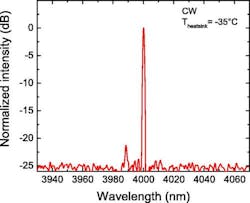TUM researchers extend VCSEL operation to the mid-IR region
Researchers from the Walter Schottky Institute at the Technical University of Munich (TUM) in Germanyare extending the wavelength coverage of vertical-cavity surface-emitting lasers (VCSELs) into the important mid-infrared (mid-IR) region, as reported in Applied Physics Letters, from AIP Publishing.1 There are several important gases that are detectable in this 3-4 micron region including methane, carbon dioxide, and nitrogen dioxide.
RELATED ARTICLE: High-power VCSELs rule IR illumination
Typical VCSELs suffer in performance for the relatively long wavelengths of the mid-IR range in part due to side-effects of heating that disproportionally affect IR wavelengths. These effects are minimized by the "buried tunnel junction" configuration of VCSELs, where a material barrier is embedded between the standard p- and n-type materials of the semiconductor. This structuring results in resistance-like behavior for the device and provides tunability of the optical properties in the desired range.
"The buried tunnel junction VCSEL concept has already yielded high-performance VCSELs within the entire 1.3- to 3-micron wavelength range," said Ganpath K. Veerabathran, a doctoral student at the Walter Schottky Institute. "And so-called type-II 'W' quantum well active regions have been used successfully to make conventional edge-emitting semiconductor lasers with excellent performance within the 3- to 6-micron wavelength range."
By combining the tunnel junction VCSEL concept with these conventional edge-emitting laser designs, where the beam is emitted in parallel with the bottom surface, in this wavelength regime, the researchers created a buried tunnel junction VCSEL with a single-stage, type-II material active region to extend the wavelength coverage of electrically pumped VCSELs.
This advance is particularly noteworthy because it's the first known demonstration ofelectrically pumped, single-mode, tunable VCSELs emitting continuous wave up to 4 microns.
"It marks a significant step from state-of-the-art devices emitting at three microns in a continuous wave, and up to 3.4 microns in pulsed mode, respectively," said Veerabathran. "Further, our demonstration at four microns paves the way for application-grade VCSELs within the entire 3- to 4-micron wavelength range, because the performance of these VCSELs generally improves at shorter wavelengths."
It's important to note that although gas-sensing systems within this wavelength range are already available using other types of lasers, they're considered to be power hogs compared to VCSELs. They also tend to be cost-prohibitive, and are mainly used by industries to detect trace gases for safety and monitoring applications.
"The 4-micron VCSEL demonstrates that low-power, battery-operated, portable and inexpensive sensing systems are within reach," Veerabathran also said. "Once sensing systems become more affordable, there's great potential for deployment by industries, such as the auto industry for emission monitoring and control, and these systems may even find uses within our homes."
Next, the group will focus on making improvements “in terms of the maximum operation temperature and optical output power of the VCSELs," Veerabathran said. "In the future, it may be possible to extend this concept to make VCSELs emit further into the mid-infrared region beyond 4 microns. This would be beneficial because the absorption strength of gases typically becomes orders of magnitude stronger, even for relatively small wavelength increases."
REFERENCE:
1. Ganpath Kumar Veerabathran et al., Applied Physics Letters 110, 7, 071104 (2017); see http://aip.scitation.org/doi/full/10.1063/1.4975813.
SOURCE: American Institute of Physics (AIP); https://publishing.aip.org/publishing/journal-highlights/extending-vcsel-wavelength-coverage-mid-infrared
About the Author

Gail Overton
Senior Editor (2004-2020)
Gail has more than 30 years of engineering, marketing, product management, and editorial experience in the photonics and optical communications industry. Before joining the staff at Laser Focus World in 2004, she held many product management and product marketing roles in the fiber-optics industry, most notably at Hughes (El Segundo, CA), GTE Labs (Waltham, MA), Corning (Corning, NY), Photon Kinetics (Beaverton, OR), and Newport Corporation (Irvine, CA). During her marketing career, Gail published articles in WDM Solutions and Sensors magazine and traveled internationally to conduct product and sales training. Gail received her BS degree in physics, with an emphasis in optics, from San Diego State University in San Diego, CA in May 1986.
